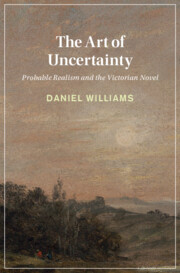Book contents
- The Art of Uncertainty
- Cambridge Studies in Nineteenth-Century Literature and Culture
- The Art of Uncertainty
- Copyright page
- Epigraph
- Contents
- Illustrations
- Acknowledgments
- Introduction
- Part I Provisional Judgments
- Part II Probable Realisms
- Chapter 3 Worlds Otherwise
- Chapter 4 Approximations
- Coda
- Notes
- Bibliography
- Index
- Cambridge Studies In Nineteenth-Century Literature And Culture
Chapter 4 - Approximations
Serial and Composite Thinking in Hardy
from Part II - Probable Realisms
Published online by Cambridge University Press: 29 February 2024
- The Art of Uncertainty
- Cambridge Studies in Nineteenth-Century Literature and Culture
- The Art of Uncertainty
- Copyright page
- Epigraph
- Contents
- Illustrations
- Acknowledgments
- Introduction
- Part I Provisional Judgments
- Part II Probable Realisms
- Chapter 3 Worlds Otherwise
- Chapter 4 Approximations
- Coda
- Notes
- Bibliography
- Index
- Cambridge Studies In Nineteenth-Century Literature And Culture
Summary
This chapter studies two contrasting models for predictive thinking and representation in Thomas Hardy. In The Return of the Native (1878), Hardy’s depiction of repetitive phenomena evokes one renovated account of logico-mathematical probability, John Venn’s empirical theory about how we judge from series of instances. In the novel’s palpably antiquated rural setting – where characters intuit more than they see, gamble by the light of glowworms, and infer human plots from long-run traces in the material world – the abstractions of Victorian logic acquire concrete form. In The Mayor of Casterbridge (1886), by contrast, serial iterations are compressed into images. Hardy designs literary equivalents of Francis Galton’s “composite photographs,” used to model statistical data and mental processes. Characters think in overlays, detecting a parent’s face playing over that of a child, designing a future self by laying transparencies over the present, and imagining human plots as grids from overhead. Serial and composite thinking extend to Hardy’s “approximative” theory of fiction. He uses these tropes as an implicit riposte to critics and advocates for a novelistic realism tolerant of repetition, coincidence, and improbability.
Keywords
- Type
- Chapter
- Information
- The Art of UncertaintyProbable Realism and the Victorian Novel, pp. 152 - 201Publisher: Cambridge University PressPrint publication year: 2024

